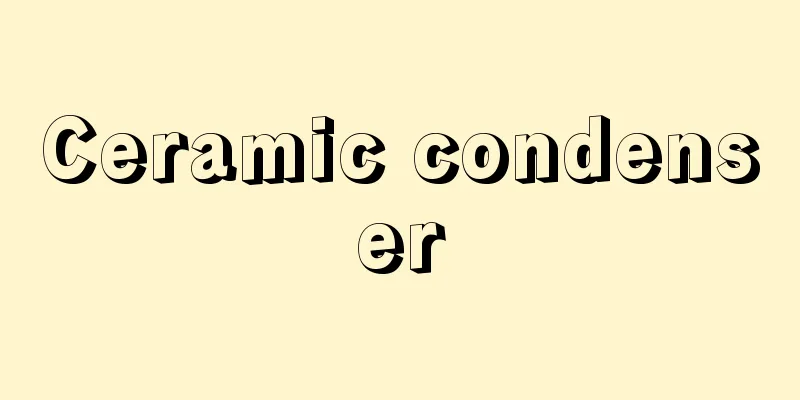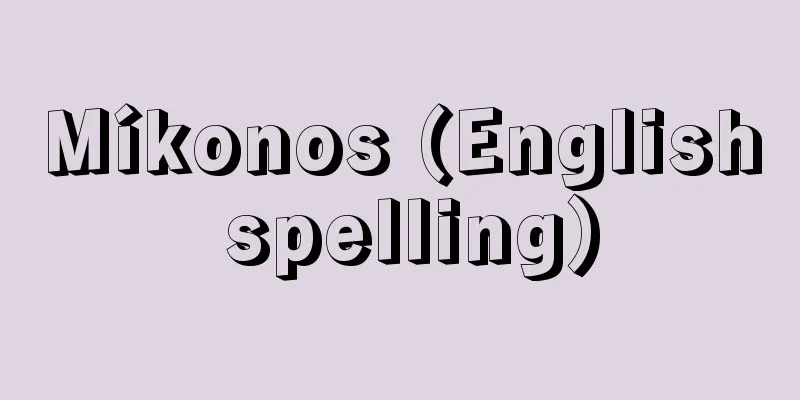Ceramic condenser

|
A general term for capacitors that use metal oxide sintered bodies (ceramics) as dielectrics. They are also called ceramic capacitors. In terms of characteristics, they are broadly divided into two types: titanium oxide ceramics, which have low loss and a controlled temperature coefficient of dielectric constant, and barium titanate ceramics, which have a large dielectric constant. In terms of structure, there are single-plate lead types, in which metal electrodes are baked on both sides of a circular (or rectangular or cylindrical) ceramic dielectric, lead wires are soldered to it, and then a dip-type insulating coating is applied, and laminated chip types, in which ceramic dielectric layers and electrode layers are alternately laminated and sintered together, and external terminal electrodes are attached. In the former structure, the thickness of the ceramic dielectric layer is limited to about 150 micrometers due to mechanical strength, but in the latter, thin-layer products with a thickness of 1 micrometer per layer have been commercialized due to advances in material technology and sheet thinning technology. Except for special applications, there are seven to eight standard shapes, ranging from ultra-small 0603 (0.6 x 0.3 mm) to 5750 (5.7 x 5.0 mm). Incidentally, multilayer ceramic chip capacitors with 1-micrometer-thick dielectric layers are being mass-produced in products with 2012 size external dimensions and a capacitance of 100 microfarads, and are gradually replacing some tantalum capacitors and aluminum electrolytic capacitors. These multilayer ceramic chip capacitors have a shape and structure suitable for surface mounting, are highly reliable, have excellent high-frequency characteristics, and can be made large in capacity, so their use in the power circuits of audiovisual equipment and information and communication equipment is expanding rapidly. Today, this multilayer chip type accounts for more than 90% of the total production of ceramic capacitors, and this trend is expected to continue in the future. [Koichiro Sakata] [Reference item] |Source: Shogakukan Encyclopedia Nipponica About Encyclopedia Nipponica Information | Legend |
|
金属酸化物焼結体(セラミック)を誘電体とするコンデンサーの総称。磁器コンデンサーともいう。特性の面からは、主として低損失で比誘電率の温度係数が制御された酸化チタン系磁器と、比誘電率の大きなチタン酸バリウム系磁器の2種類に大別される。構造面からは、円板(または角板、円筒)状セラミック誘電体の両面に金属電極を焼き付けリード線をはんだ付けした後、ディップ形絶縁塗装を施した単板リード形と、セラミック誘電体層と電極層を交互に積層一体化焼結し外部端子電極をつけた積層チップ形とがある。前者の構造ではセラミック誘電体層の厚さは機械的強度の関係で150マイクロメートル程度が限度であるが、後者では材料技術やシート薄層化技術の進歩により1層の厚さが1マイクロメートルの薄層品が商品化されている。特殊な用途を除いて標準的な形状では、0603(0.6×0.3ミリメートル)の超小型品から5750(5.7×5.0ミリメートル)まで7~8種類がある。ちなみに1マイクロメートル厚誘電体層の積層セラミックチップコンデンサーでは2012サイズの外形寸法で静電容量が100マイクロファラドの製品が量産化され、一部のタンタルコンデンサーやアルミ電解コンデンサーからの置き換えが進みつつある。 こうした積層セラミックチップコンデンサーは、表面実装に適した形態と構造をもつこと、信頼性が高いこと、高周波特性が優れていること、大容量化が可能になったことなどにより、映像音響機器や情報通信機器の電源回路などへの用途が急拡大している。今日ではセラミックコンデンサー全生産量の90%以上をこの積層チップ形が占めており、今後もこの傾向は続くものと考えられる。 [坂田好一郎] [参照項目] |出典 小学館 日本大百科全書(ニッポニカ)日本大百科全書(ニッポニカ)について 情報 | 凡例 |
<<: Ceramics - Ceramic (English spelling)
Recommend
Lope de Rueda
Spanish playwright. Born in Seville and died in C...
not five meters
…there is a scrum for the opposing team at that s...
Kimura Hitachisuke
Year of death: 15th July 4th Bunroku (20th August ...
Chambers, R.
…However, both theories of evolution are consider...
Green foxtail - Enokorogusa
An annual weed of the grass family (APG classific...
Yacht - yacht (English spelling)
A general term for boats used for travel, cruisin...
Jeju - last week
It is the largest city on Jeju Island, located in...
Early Summer - Early Summer
...The majority of varieties currently available ...
Ame no Hiboko
A prince of Silla who appears in the legends of th...
History of economic theory
[The Significance of Researching the History of E...
Galuppi, B. (English spelling) GaluppiB
…Scarlatti left behind 600 harpsichord sonatas, w...
Reserve - Reserve
A credit account that arises from the recording o...
Hammer - Tweet
[Kanji for personal names] [Sound] Tsui (Kanji) [R...
Tartaric acid (English spelling)
It is a hydroxycarboxylic acid. It is also called...
Kashiwa - Kashiwa
A deciduous tall tree of the Fagaceae family that ...









